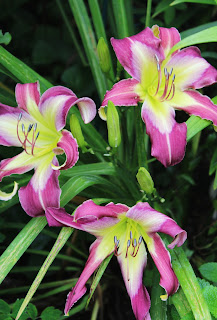DAYLILIES MARK THE END OF ACTIVE DUTY IN THE GARDEN
 |
| H. 'Prissy Frills,' a spider daylily |
The last
daylily is blooming now. Hemerocallis ‘Autumn Minaret’ is a cross
between two species daylilies, H.
altissima, the late-blooming yellow daylily that can grow as tall as six
feet, and H. fulva, the common orange
‘ditch lily’ that has provided breeding stock to so many of our fancier
hybrids. ‘Minaret’ is a favorite of mine
because it extends the daylily season, coming as it does near the end of July,
and the five-foot-tall stalks do look like elegant candles burning at the back
of the border above the richly-toned leaves of the ‘Coppertina’ ninebark and clumps
of black-eyed Susans.
 |
| H. 'Autumn Minaret' |
I firmly
believe that you can never have too many daylilies, or too many ‘lilies’ for
that matter, which is why daylilies in my garden rub shoulders with true lilies
(lillium), along with crinum lilies,
ginger lilies, rain lilies, and more. Daylilies
are well-suited to heat as well as to changing conditions. Their tuberous root systems are highly forgiving
and they allow themselves to be dug up and moved or divided repeatedly without
holding any grudges. Generally speaking,
they prefer well-drained soil, and will be happy with soil on the lean side so
long as it isn’t compacted and the lilies aren’t competing with tree
roots. Full sun is a must, and in late
spring when the foliage is putting out plenty of new growth, be vigilant for
thrips, which can undermine the plant’s health.
Use insecticidal soap on the leaves, after crushing as many of the tiny
pests as you can with your hands.
 |
| H. 'Superstition' |
 |
| H. 'Swallowtail's Gate' |
Because daylilies
increase so readily, you will be forever taking part in the karmic exchange of favored
plants with your gardening friends, thus keeping the good vibes going. I have shared many clumps of H. ‘Kalahari,’ a
vigorous, big-flowered, apricot workhorse, as well as the better-known ‘Pandora’s
Box’ which complements so many landscapes with its smallish, creamy flower
sporting a lavender eye. I was lucky to
come by ‘Hyperion’ in a plant swap, an old standby valued for its lemony
fragrance as well as its hardiness and profusion of yellow blooms. ‘White Temptation,’ ‘African Diplomat,’ and
‘Pat of Butter’ were pass-alongs from my neighbor and gardening buddy, Steve,
along with a demure mauve variation of ‘Pat of Butter’ that hasn’t got a name
but which is one of my personal favorites.
(‘Pat of Blackberry Gelato’ would describe it adequately, but is too
long to fit on a label.)
I have a
weakness for spider daylilies, those long-stalked varieties whose petals twist
like pinwheels. ‘Lois Burns’ is a yellow
spider with mango-colored streaks on her edges.
She is complemented in her spot atop the retaining wall by an enormous Rosmariunus prostratus spilling over the
stones below her. ‘Prissy Frills’ puts
‘Lois’ in the shade, however, when this spider blooms a week or so later. ‘Prissy’ is more generously endowed where
buds are concerned, and her gangly flowers are decked out in carnival colors.
If you’re
going to have over-sized daylilies, you need to have dwarf specimens as well, in
order to balance the collection. My nod
in that direction is to the aptly named H.
‘Little Peanut,’ a reddish-orange charmer which has proven sturdier than some
of the other dwarf varieties I’ve tried, and has increased happily in the lower
garden where she edges a bed of Salvia
guarnitica ‘Black and Blue.’
 |
| H. 'Duchess of Parma' with Tradescantia virginiana 'Martha Washington's Bonnet' |
I’m not an
artist at heart, so the most visually pleasing plant combinations in my garden
nearly always occur by lucky accident.
That has been the case with H.
‘Duchess of Parma,’ a voluptuous, peach-colored diva which blooms against a
backdrop of Tradescantia virginiana ‘Martha
Washington’s Bonnet.’ In full flower this unusually tall and floriferous
spiderwort is covered in blossoms that are a breath-catching shade of Della
Robbia blue.
 |
| H. '100th Anniversary' with Loropetalum chinense 'Peppermint |
One of the few combinations I actually planned that has proven successful is a grouping at the edge of the shade garden consisting of H. 'Chicago Picotee,' Eucomis 'Sparkling Burgundy,' and Acer palmatum 'Sumi-nagashi.' The daylily's crimped edges and glowing complexion is shown to great advantage against the glossy, long-bladed leaves of the purple pineapple lily. The dark tones of the lily's foliage are repeated in the lacy, textured leaves of the Japanese maple, which emerge purple-black in the spring, turning crimson by autumn.
 |
| H. 'Chicago Picotee,' Eucomis 'Sparkling Burgundy,' and Acer palmatum 'Sumi-nagashi' |
But at this
point in the summer, gardening becomes a test of endurance, even survival. Before heading out to work on these days when
the heat index tops 100, I must slather on the sunblock, spray insect repellent
over that and for good measure slip on my mosquito-deterring wristband. Then I take up the wide-brimmed straw hat –
the brim a necessity after a spider dropped from a tree several years ago and
bit the back of my neck, sending me into anaphylactic shock and requiring an
expensive ambulance ride to the Emergency Room.
The hat is followed by latex gloves that are also non-negotiable in
mid-July, given how many spiny caterpillars are working the vegetation in full
camouflage. A sting from one of these,
probably the saddleback moth caterpillar which feeds on roses and blueberries,
puffed my hand up to twice its size not long ago. I considered myself lucky not to be knocked
unconscious.
Ever since
the ER visit, I have followed the doctor’s advice and kept liquid Benadryl on
hand to stave off allergic reactions to insect and caterpillar bites. (Epinephrine-pens are a good idea as well,
but they are costly.) When fire ants
swarmed up my legs last week and stung my ankles despite that fact that I
garden in thick socks and long pants, I downed four teaspoons of Benadryl immediately,
and stayed vertical. As anyone who’s
been bit by these horrible pests knows, the itching from the stings is
formidable, but it can be controlled by frequent applications of
Benadryl gel. That’s a much better
alternative to rescue by firemen.
As I move through
the process of suiting up, I must do so to a chorus of whimpers and barks from
my dog, Tiny Alice, who is beside herself with impatience to get out in the
yard. She is on Cloud 9 when we get
there, but with a dew point above 70 I am soon sweating like a block of cheese
in a microwave. By the time I’ve reached
my limit of heat tolerance and have gathered tools, dog, and gear to come
inside, it’s time for my second shower of the day, a full-body check for ticks,
hydration via a gallon of cold liquid, and a heat-recovery nap on the
couch.
 |
| H. 'Elizabeth Ferguson' |
This is why
I’m resigned to mostly hanging up my gardening gloves for the coming six weeks or
so, leaving the garden to the fire ants, the unsociable saddlebacks, Japanese
beetles and bindweed. In autumn I’ll
catch my second wind, as will the plants, and we’ll come together once again in
a relationship based on pleasure, rather than pain.
Access information about growers, events, regional chapters and all things having to do with daylilies on this colorful website of the American Hemerocallis Society:
http://www.daylilies.org/
Access information about growers, events, regional chapters and all things having to do with daylilies on this colorful website of the American Hemerocallis Society:
http://www.daylilies.org/



Comments
Post a Comment
Thanks for dropping by!